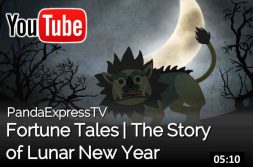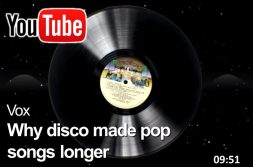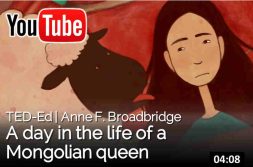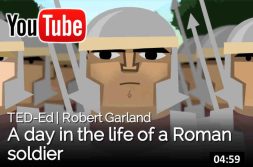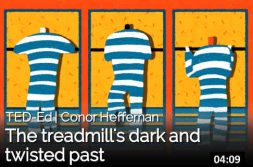History & Culture
Culture
A weekly show where knowledge junkies get their fix of trivia-tastic information. It’s our birthday! In celebration of a year of mental_floss on YouTube, John looks at some fascinating birthday traditions from around the world.
In this video, learn all about the traditions and legends that make Lunar New Year one of the most exciting times of the year.
[more]
Lesson by Alex Gendler, animation by Igor Coric.
[less]
In this episode of Overrated, Vox’s Phil Edwards gets nunchucked in his heart by ninjas. But why are these
[more]
The history of ninjas is, fittingly, one with many hidden twists and turns. It starts with the real historical ninjas in feudal Japan, who really did practice what we call ninjutsu. Their mixture of espionage, assassination, and combat was similar to what ninja-fans might imagine, though the reality was more about traveling incognito than looking cool in a black jumpsuit.
From there, the ninja quickly became a myth in Japanese culture, entering kabuki theatre as well as manga and novels of the time. Already, the exaggeration of the ninja in Japan had begun, a trend that continued with myth-making Japanese films that vaulted the imaginary ninja into public consciousness.
Finally, the ninja traveled to the West from these Japanese films, first showing up in James Bond, and then becoming part of a ninja-sploitation trend. Soon, Teenage Mutant Ninja Turtles proved the ninja was so famous it could take on postmodern incarnations.
But nearly from the beginning, the ninja was as powerful an idea as a reality, a myth in both Japanese and western culture. And, perhaps most importantly, every version of the ninja — real or not — turned out to be awesome.
[less]
[more]
[less]
The crazy story of the arbitrary temperature scale used in a tiny minority of countries.
Since I’ve moved to the US in 2010, there’s one thing that I still don’t fully understand: the imperial system.
[more]
[less]
In the early 1970s, a musical sensation took over New York City. It was called Disco. Before Disco
[more]
By 1973, their influence as musical taste makers became apparent, and a handful of unconventional dance tracks became pop crossover hits. With barely any radio airplay, songs like “Love Theme” and “Girl You Need a Change of Mind” became defining tracks of the disco era.
These songs were repetitive, hypnotic, and funky, and they were also pretty long compared to other pop hits. That presented a problem for DJs using 7-inch 45rpm singles, which fit only 3:30 minutes of quality audio on them, during their night-long sets. They needed a vinyl record that could make their most popular tracks sound powerful on a dance floor and last the whole night.
In 1976, an accidental studio discovery by Disco pioneer Tom Moulton provided the solution: A 12-inch single. By stretching one song across 12 inches of vinyl, a format typically reserved for full-length albums, those extended dance tracks had room to breath.
By the 1980s, the 12-inch single dominated pop music. It not only changed the sound of records, it allowed for music producers to experiment with length and structure.
[less]
OK is thought to be the most widely recognized word on the planet. We use it to communicate with each
[more]
Young intellectuals in Boston came up with several of these abbreviations, including “KC” for “knuff ced,” “OW” for “oll wright,” and KY for “know yuse.” But thanks to its appearance in Martin Van Buren’s 1840 presidential re-election campaign as the incumbents new nickname, Old Kinderhook, OK outlived its abbreviated comrades.
Later, widespread use by early telegraph operators caused OK to go mainstream, and its original purpose as a neutral affirmative is still how we use it today.
[less]
History
[more]
Since their emergence over 200,000 years ago, modern humans have established communities all over the planet. But they didn’t do it alone. Whatever corner of the globe you find humans in today, you’re likely to find another species as well: dogs. So how did one of our oldest rivals, the wolf, evolve into man’s best friend? David Ian Howe traces the history of humanity’s first domesticated animal.
Lesson by David Ian Howe, directed by Cabong Studios.
[less]
[more]
Lesson by Anne F. Broadbridge, directed by Els Decaluwe.
[less]
[more]
Lesson by Robert Garland, animation by Brett Underhill.
[less]
The development of agriculture was a huge game changer for human beings and it may have even changed the way we speak.
[more]
[less]
[more]
Lesson by Scott A. Mellor, directed by Remus and Kiki.
[less]
[more]
Lesson by Eva-Maria Geigl, directed by Chintis Lundgren.
[less]
[more]
Lesson by Megan Campisi and Pen-Pen Chen, animation by Zedem Media.
[less]
[more]
[less]
[more]
[less]
[more]
Lesson by Elizabeth Cox, directed by Inna Phillimore.
[less]
A lot of old photos from the 19th and early 20th century are fraught with doom and gloom—and on the
[more]
[less]
[more]
[less]
Law
[more]
[less]

